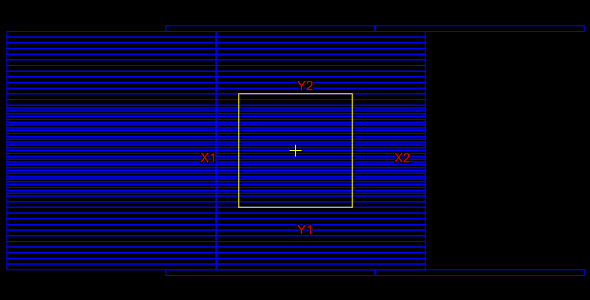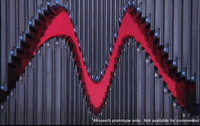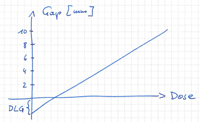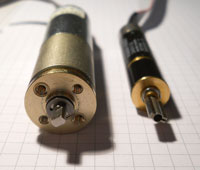We measured the dosimetric MLC parameters Transmission and Dosimetric Leaf Gap (DLG) for the HD120® "High-Definition" MLC of our TrueBeam STx. The data is needed to configure the five photon energies in Eclipse Beam Configuration.
The HD120 has 60 leaf pairs with 2.5 mm leaf width1 in the central region (32 leaf pairs spanning 8 cm), and 5 mm leaf width in the periphery. This gives a maximum MLC field length of 22 cm.
Linac Setup
The setup process on the machine side is easy. Varian provides DICOM plans for the determination of the DLG, one plan per energy, with versions for Millenium-MLC and the HD120 MLC. All necessary files plus an exercise document which describes the DLG measurement step-by-step can be found on my.varian.com2.
Each DICOM plan contains 10 fields with a fixed field size (jaw size) of 10x10 cm, and 100 MU: one open field, two static MLC fields (see screenshot below), and seven dynamic (sliding window) fields. Although the task is called "Dosimetric Leaf Gap Measurement" by Varian and the dose readings of the open fields are not needed for the subsequent DLG computation, one should measure them3: then the static MLC transmission can be determined en passant.
Here is the MLC setup for the measurement of transmission through bank A:

The first and last leaf pairs are shifted, so that the carriage of bank A is not allowed to move forwards. Otherwise this would additionally shield the beam, and distort the result.
For the determination of static MLC transmission, dose readings are taken for open field and under leaf banks A and B. The value entered into Eclipse is the average of the transmission through leaf banks A and B, and is strictly valid only for a 10x10 field4.
The seven fields for the determination of the DLG are sliding windows with gap widths of 2, 4, 6, 10, 14, 16 and 20 mm. Readings are taken for each gap width. An extrapolation to zero dose gives a negative gap width, which is the DLG (see sidebar).
In contrast to the original files, we set the collimator to 90° so that chamber axis and direction of leaf movement were perpendicular. This was simply because we didn't want to rotate the water phantom. Dose rate was 400 MU/min for all energies, as in the DICOM plans.
Phantom Setup
The large PTW-MP3 water phantom was set up at SSD 90 cm. A waterproof PTW 30013 Farmer chamber was placed at 10 cm depth. Dose was measured with a Unidoswebline dosemeter in range "Med" for open fields and "Low" for blocked fields.
All readings were corrected for chamber saturation using the 2-parameter method of Bruggmoser. The dose per pulse (DPP) at the location of the chamber is much higher in the open field than under the MLC (up to nearly 1 mGy for 10FFF). If they were the same, the saturation corrections would cancel out when the transmission is calculated.
Results
In the following table, columns 2 and 3 contain the uncorrected transmission values through the two leaf banks, whereas column 4 contains the average value, as entered into Eclipse (e.g., 0.0124 for 1.24% transmission). This value contains the saturation correction.
The dose per pulse is in column 5 and the resulting saturation correction factor kS(open) for the Farmer chamber and the open field is in column 6. The correction factor for the blocked field is very close to one.
The last column is the dosimetric leaf gap, which is also needed for Eclipse. In Eclipse, it has to be entered in units of [cm]. The DLG values link to the graphs with the Excel linear extrapolation (see also sketch in sidebar):
| Energy | TransmA | TransmB | Eclipse | DPP [mGy] | kS(open) | DLG [mm] |
|---|---|---|---|---|---|---|
| X6 | 1.21% | 1.27% | 0.0124 | 0.218 | 1.0019 | 0.412 |
| X10 | 1.37% | 1.44% | 0.0140 | 0.246 | 1.0021 | 0.495 |
| X15 | 1.33% | 1.40% | 0.0136 | 0.514 | 1.0044 | 0.480 |
| 6FFF | 1.03% | 1.09% | 0.0106 | 0.477 | 1.0041 | 0.329 |
| 10FFF | 1.23% | 1.30% | 0.0125 | 0.916 | 1.0079 | 0.451 |
In the linked plots of the last column, the horizontal axis is the dose in Gy (the unit is not important). The vertical axis is the gap width in [mm]. Therefore, when the Excel fit function is used, the intercept at x = 0 (zero dose) comes out in [mm] too.
1All leaf widths are @ isocenter distance.
2Search for keyword "Dosimetric Laf Gap", or look for Doc type "Education Materials", document "Dosimetric Leaf Gap Measurement Exercise".
3The purpose of open field, according to the exercise document, is only for detector alignment and warm up. The transmission fields are used to correct the (uncorrected) gap reading.
4Only one value may be entered into Eclipse beam configuration. Eclipse still does not distinguish between interleaf and intraleaf transmission. Therefore one should go for "averaged" values, using a large volume ionization chamber with its intrinsic averaging.



